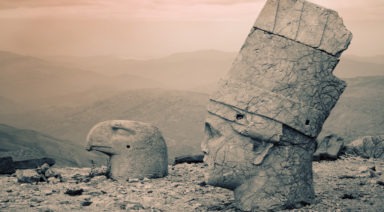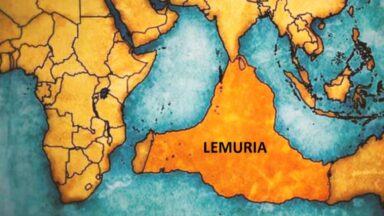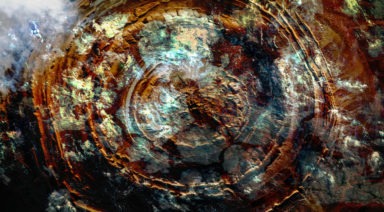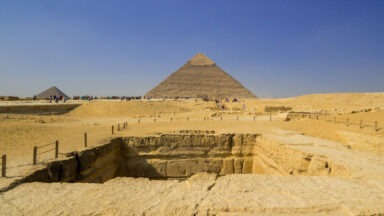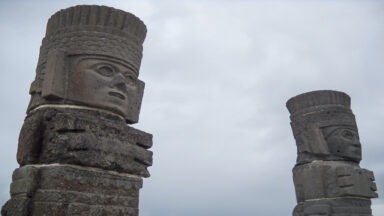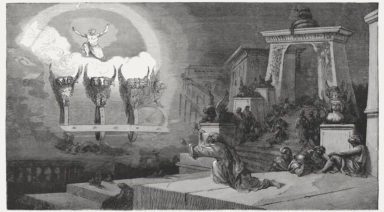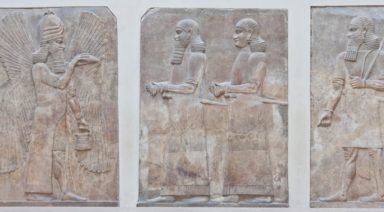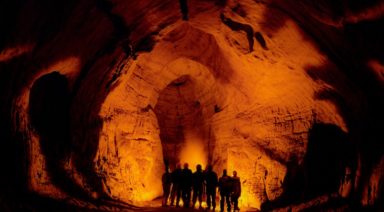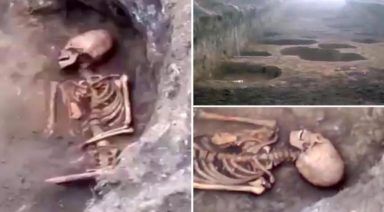These Hindu Texts Describe Flying Vimanas And Details Of An Ancient Nuclear War

The Hindu Vedas are packed with fantastic stories about the gods, their powers, and epic battles that supposedly took place long ago. Their sagas are widely perceived to be mythological stories that were created to be taken as allegory, much like we tell our children fables, so they might glean useful life lessons to apply down the road. These Hindu myths talk of noble Gods who fight off wicked forces, flying craft called Vimanas, and … nuclear war? Are we sure these were just allegories?
Vimana Technology
The Vimana aircraft that are described in ancient Hindu Sanskrit texts are flying machines of varying degrees. The word Vimana translates to “having been measured out” or “traversing,” and were machines piloted by the gods. Much like the chariots of biblical texts, most notably the one seen in Ezekiel’s vision of the wheel, these flying craft came in all shapes and sizes and could travel at different speeds and distances. Some were land and seafaring vehicles, while others flew, sometimes all the way to the moon or further.
The most well-known documentation of the ancient Vimana flying machines comes from the Vaimānika Śāstra, an early 20th century translation of many accounts of Vimana technology found in ancient Vedic scriptures. It details drawings of a range of crafts, including the sources of fuel used to power them, although some can be confusing. The translations talk of certain elements and minerals we are familiar with, like mica, quicksilver and mercury, but also mentions strange liquids referred to as honey, which may have been an unknown substance with a similar viscosity or appearance to a bee’s nectar.

On top of every Hindu temple or pyramid, one can find a Vimana, and often they are rounded, saucer-like objects, which certain theorists believe were the vehicles of extraterrestrials. Erich von Däniken points out the modern sightings that created our perception of UFOs look very similar to the Vimanas of ancient India.
Von Däniken also points out that the depiction of Shiva flying on his bird, Garuda, could easily have been a primitive description of an airplane or spacecraft. Garuda was known for dropping bombs, flying to the moon, and bringing Shiva to different locations throughout the solar system. In trying to explain this sight to future generations, the elders’ story of a “god” flying around on a “giant bird” or “bird-like” craft might sound ridiculous and be considered merely mythological to those who may have never witnessed it.
When we look closer at these Vimanas, the descriptions of the sounds they made and the way they looked when they took off begin to resemble jet propulsion more and more. One translation of a passage in the Vedic Mahabharata describes a Vimana.
“The Vimana had all necessary equipment. It could not be conquered by the gods or demons. And it radiated light and reverberated with a deep rumbling sound. Its beauty captivated the minds of all who beheld it. Visvakarma, the lord of its design and construction, had created it by the power of his austerities, and its outline, like that of the sun, could not be easily delineated.”
The passages speak of Krishna’s cohort and epic hero of the Baghavad Gita, Arjuna, describing a trip he took in a Vimana into the heavens, where he saw thousands of airborne chariots and another massive Vimana that was seven stories tall. Much like Enoch’s trip taken up in a wheeled chariot, Von Däniken says he believes that this could have been a primitive interpretation of a trip to the mothership, from which the many Vimanas seen on Earth could have originated.
The Drona Parva’s Nuclear War
One of the strangest stories of the ancient Hindu Vedas comes from a translation of the Drona Parva, the seventh book in the Mahabharata. The book describes Drona, a warrior appointed as leader of an army in the Kurukshetra War and his ensuing death in that battle. The story fits in with themes seen elsewhere in the Mahabharata, and other ancient texts that detail the difficulties of war, but this particular book provides some descriptions that sound eerily similar to the effects of a nuclear war.
Explosions that level everything, animals screaming and engulfed in flames, pregnant women’s babies dying and metal armor melting onto the skins of warriors who wear them, all sound like the result of nuclear blast. It mentions birds falling from the sky, due to a single projectile charged with all the power of the universe, as bright as a thousand suns.
“We beheld in the sky what appeared to us to be a mass of scarlet cloud resembling the fierce flames of a blazing fire. From that mass many blazing missiles flashed, and tremendous roars, like the noise of a thousand drums beaten at once. And from it fell many weapons winged with gold and thousands of thunderbolts, with loud explosions, and many hundreds of fiery wheels,”(source).

Were these scarlet clouds resembling blazing fires and the subsequent death and destruction in the ancient scriptures describing the effects of a nuclear fallout? The primitive technology of the time couldn’t have been exposed to radiation of any sort, though the descriptions of pregnant mother’s babies dying sounds very much like the effects of radiation exposure.
After we developed the atomic bomb that was dropped on Hiroshima and Nagasaki, J. Robert Oppenheimer even quoted the Baghavad Gita saying, “Now I am become death, the destroyer of worlds.” Oddly enough, Oppenheimer, who developed the bomb, was also a scholar of Sanskrit, and some have compared his story to that of Arjuna in the Bhagavad Gita. Arjuna must be convinced to fight in a battle he does not want to take part in due to a moral dilemma, which some have compared to Oppenheimer’s hesitance in developing the atomic bomb.
The Unexplained Destruction of Mohenjo Daro and Harappa
The remnants of two ancient civilizations in the Indus Valley of modern day Pakistan and India have puzzled archeologists for decades. These cities were both deserted suddenly, coincidentally around the time of the construction of the great pyramids in Egypt, despite having been thriving centers of technology and culture for centuries. Mohenjo Daro, in particular, appears to have been flattened, or collapsed after 600 years of being inhabited. Could this have been the location of what may have been an ancient nuclear war?
Mohenjo Daro and Harappa are anomalous not just because of their desertion by the people who lived there, but also because of their incredibly advanced technology and decentralized, secular society. Archeologists have determined that the layout of these two massive cities shows evidence of an egalitarian civilization with no distinct hierarchy or elite ruling class and was likely governed by elected officials. The ruins of Mohenjo Daro show careful urban planning, advanced irrigation and drainage systems, and a 900 sq. foot, watertight, communal bath that was filled by the Indus river. This civilization spanned over 500 acres and supported a population of somewhere between 20,000 – 40,000 citizens.

Ruins of Mohenjo Dara via nationalgeographic.com
Harappa, which came into ruin around the same time as Mohenjo Daro, was equally as advanced, with granaries, superstructures, and calculated trading practices. These civilizations had board games like chess, traded precious gems and jewelry, and valued cleanliness and hygiene. Both were civilizations with thriving cultures that disappeared suddenly and without explanation.
Excavations at Mohenjo Daro unearthed the skeletons of a family holding hands, appearing to have been flattened with rubble and ash covering them as if they had died in an abrupt and unforeseen event. Some accounts say that a layer of radioactive ash was found in the soil before the site was dug up, adding to the theory of a nuclear event that could have been the cause of destruction of this ancient city.
These claims however are somewhat unsubstantiated with insufficient evidence to support the discovery of this radioactive material. It is strange though, that these two highly advanced civilizations experienced apocalyptic events at the same time while being situated within the same region, but still being many miles apart.
Whether these stories found in the ancient Vedic scriptures actually provide evidence of a nuclear war or not, they seem to at least describe some incredibly advanced, apocryphal technology. Could there really have been flying crafts and a nuclear event that wiped out these two ancient civilizations like the one described in the Mahabharata? If so, could these “gods,” who were behind this technology, actually have been an extraterrestrial species with advanced technology that is common to us today?
Are These Out of Place Artifacts Evidence of Ancient Alien Technology?
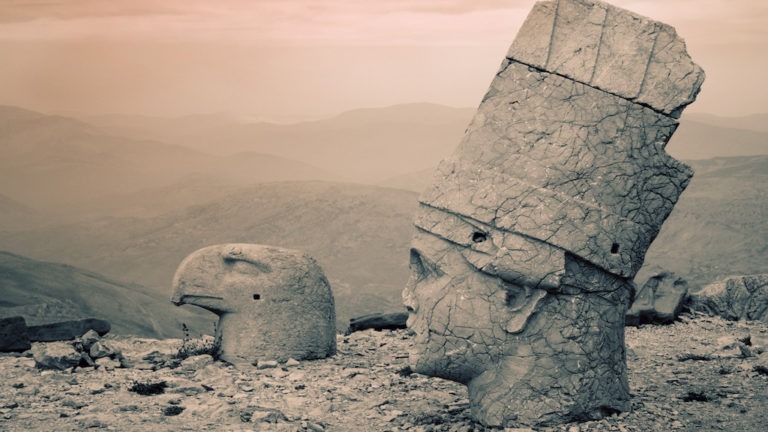
The evolution of technology follows a pretty linear path throughout history. But sometimes we stumble upon anachronistic artifacts that challenge that perception and throw those perceived timelines for a loop. To some, these out of place artifacts are none other than ancient alien technology proving our ancestors were once visited by an advanced race, while others maintain it’s evidence we’ve underestimated the technological faculties of those ancestors.
Here’s a list of alleged ancient alien artifacts — you decide for yourself.
Puma Punku’s Ancient Technology Mysteries
Growing up, most are taught that the Egyptians built the pyramids through primitive means, using simple pulleys and brute force from slave labor. But under deeper scrutiny, this explanation doesn’t seem to make sense. And the same could be said about the temple complex of Puma Punku in Bolivia.
The temple grounds of Puma Punku are believed to date back to between 536 and 600 AD, constructed by a civilization appearing to have been wiped out by a cataclysmic event. Puma Punku is part of the larger, well-known Tiwanaku site, an important location to the Incas, who believe it is the cradle of their civilization – characteristics ancient astronaut theorists might consider significant as well.
This area of Tiwanaku is marked by a decorated megalithic archway known as the “Gate of the Sun,” and according to Freddy Silva, it may be one of the world’s oldest temples. Once home to somewhere between 10,000 and 20,000 people, the name Tiwanaku translates to “navel at the center,” implying it once served as a cultural hub.
Atop the Gate of the Sun is a carving of (https://www.gaia.com/article/viracocha-the-great-creator-god-of-the-incas), the supreme God of the Incas. Silva says that Viracocha and his ilk were described as being much different than the indigenous Incas – white-skinned, bearded, fair-headed, and capable of bending the laws of nature. They were also significantly taller. And these weren’t descriptions of the Conquistadors – they didn’t come along for about another century.
The reports of Viracocha’s superhuman race make the anomalous stonework at Puma Punku all the more interesting. Perfect 90-degree angles, precision cuts, and immaculately even spacing in the stones are shocking, considering the primitive epoch in which they were made. Much of this craft stonework remains distinct to this day, confounding scientists and archeologists alike.

What technology could they have possessed to create such fine masonry and who were the people responsible for such precision work?


